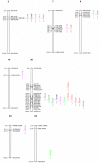Genetic and phenotypic effects of chromosome segments introgressed from Gossypium barbadense into Gossypium hirsutum
- PMID: 28931074
- PMCID: PMC5607130
- DOI: 10.1371/journal.pone.0184882
Genetic and phenotypic effects of chromosome segments introgressed from Gossypium barbadense into Gossypium hirsutum
Abstract
MBI9915 is an introgression cotton line with excellent fiber quality. It was obtained by advanced backcrossing and continuous inbreeding from an interspecific cross between the upland cotton (Gossypium hirsutum) cultivar CCRI36 as the recurrent parent and the sea island cotton (G. barbadense) cultivar Hai1, as the donor parent. To study the genetic effects of the introgressed chromosome segments in G. hirsutum, an F2 secondary segregating population of 1537 individuals was created by crossing MBI9915 and CCRI36, and an F2:3 population was created by randomly selecting 347 individuals from the F2 generation. Quantitative trait locus (QTL) mapping and interaction for fiber length and strength were identified using IciMapping software. The genotype analysis showed that the recovery rate for MBI9915 was 97.9%, with a total 6 heterozygous segments and 13 homozygous segments. A total of 18 QTLs for fiber quality and 6 QTLs for yield related traits were detected using the two segregating generations. These QTLs were distributed across 7 chromosomes and collectively explained 0.81%-9.51% of the observed phenotypic variations. Six QTLs were consistently detected in two generations and 6 QTLs were identified in previous studies. A total of 13 pairs of interaction for fiber length and 13 pairs of interaction for fiber strength were identified in two generations. Among them, 3 pairs of interaction for fiber length and 3 pairs of interaction for fiber strength could be identified in all generations; 4 pairs of interactions affected fiber length and fiber strength simultaneously. The results clearly showed that 5 chromosome segments (Seg-5-1, Seg-7-1, Seg-8-1, Seg-20-2 and Seg-20-3) have important effects on fiber yield and quality. This study provides the useful information for gene cloning and marker-assisted breeding for excellent fiber related quality.
Conflict of interest statement
Figures




Similar articles
-
QTL mapping and genetic effect of chromosome segment substitution lines with excellent fiber quality from Gossypium hirsutum × Gossypium barbadense.Mol Genet Genomics. 2019 Oct;294(5):1123-1136. doi: 10.1007/s00438-019-01566-8. Epub 2019 Apr 27. Mol Genet Genomics. 2019. PMID: 31030276
-
Identification of Chromosome Segment Substitution Lines of Gossypium barbadense Introgressed in G. hirsutum and Quantitative Trait Locus Mapping for Fiber Quality and Yield Traits.PLoS One. 2016 Sep 7;11(9):e0159101. doi: 10.1371/journal.pone.0159101. eCollection 2016. PLoS One. 2016. PMID: 27603312 Free PMC article.
-
Mapping quantitative trait loci for lint yield and fiber quality across environments in a Gossypium hirsutum × Gossypium barbadense backcross inbred line population.Theor Appl Genet. 2013 Jan;126(1):275-87. doi: 10.1007/s00122-012-1980-x. Epub 2012 Oct 12. Theor Appl Genet. 2013. PMID: 23064252
-
Fiber Quality Improvement in Upland Cotton (Gossypium hirsutum L.): Quantitative Trait Loci Mapping and Marker Assisted Selection Application.Front Plant Sci. 2019 Dec 11;10:1585. doi: 10.3389/fpls.2019.01585. eCollection 2019. Front Plant Sci. 2019. PMID: 31921240 Free PMC article. Review.
-
Inheritance, QTLs, and Candidate Genes of Lint Percentage in Upland Cotton.Front Genet. 2022 Mar 31;13:855574. doi: 10.3389/fgene.2022.855574. eCollection 2022. Front Genet. 2022. PMID: 35450216 Free PMC article. Review.
Cited by
-
Dissecting the Superior Drivers for the Simultaneous Improvement of Fiber Quality and Yield Under Drought Stress Via Genome-Wide Artificial Introgressions of Gossypium barbadense into Gossypium hirsutum.Adv Sci (Weinh). 2024 Sep;11(34):e2400445. doi: 10.1002/advs.202400445. Epub 2024 Jul 10. Adv Sci (Weinh). 2024. PMID: 38984458 Free PMC article.
-
High-density genetic variation maps reveal the correlation between asymmetric interspecific introgressions and improvement of agronomic traits in Upland and Pima cotton varieties developed in Xinjiang, China.Plant J. 2020 Jul;103(2):677-689. doi: 10.1111/tpj.14760. Epub 2020 May 4. Plant J. 2020. PMID: 32246786 Free PMC article.
-
Identification of Candidate Cotton Genes Associated With Fiber Length Through Quantitative Trait Loci Mapping and RNA-Sequencing Using a Chromosome Segment Substitution Line.Front Plant Sci. 2021 Dec 14;12:796722. doi: 10.3389/fpls.2021.796722. eCollection 2021. Front Plant Sci. 2021. PMID: 34970293 Free PMC article.
-
The Pivotal Role of Major Chromosomes of Sub-Genomes A and D in Fiber Quality Traits of Cotton.Front Genet. 2022 Mar 24;12:642595. doi: 10.3389/fgene.2021.642595. eCollection 2021. Front Genet. 2022. PMID: 35401652 Free PMC article. Review.
-
QTL mapping and genetic effect of chromosome segment substitution lines with excellent fiber quality from Gossypium hirsutum × Gossypium barbadense.Mol Genet Genomics. 2019 Oct;294(5):1123-1136. doi: 10.1007/s00438-019-01566-8. Epub 2019 Apr 27. Mol Genet Genomics. 2019. PMID: 31030276
References
-
- Huang ZK. Genetics and breeding of cotton in China. Jinan: Shandong Science and Technology Press, 2003.
-
- Qian N. Genetic diversity and association analysis of gene(QTL) of breeding target traits of upland cotton abstract. Nanjing: Nanjing Agricultural University, 2009
-
- Smith CW. Coyle GG. Association of fiber quality parameters and within-boll yield components in Upland cotton. Crop Sci. 1997; 37:1775–1779
-
- Liu JY, Zhao GR, Li J. Molecular engineering on quality improvement of cotton fiber. Acta Bot Sin.2000; 42(10):991–995
-
- Clement JD, Constable GA, Stiller WN, Liu SM.Negative associations still exist between yield and fiber quality in cotton breeding programs in Australia and USA. Field Crop Res.2012; 128(2), 1–7.
MeSH terms
Substances
LinkOut - more resources
Full Text Sources
Other Literature Sources
Miscellaneous

